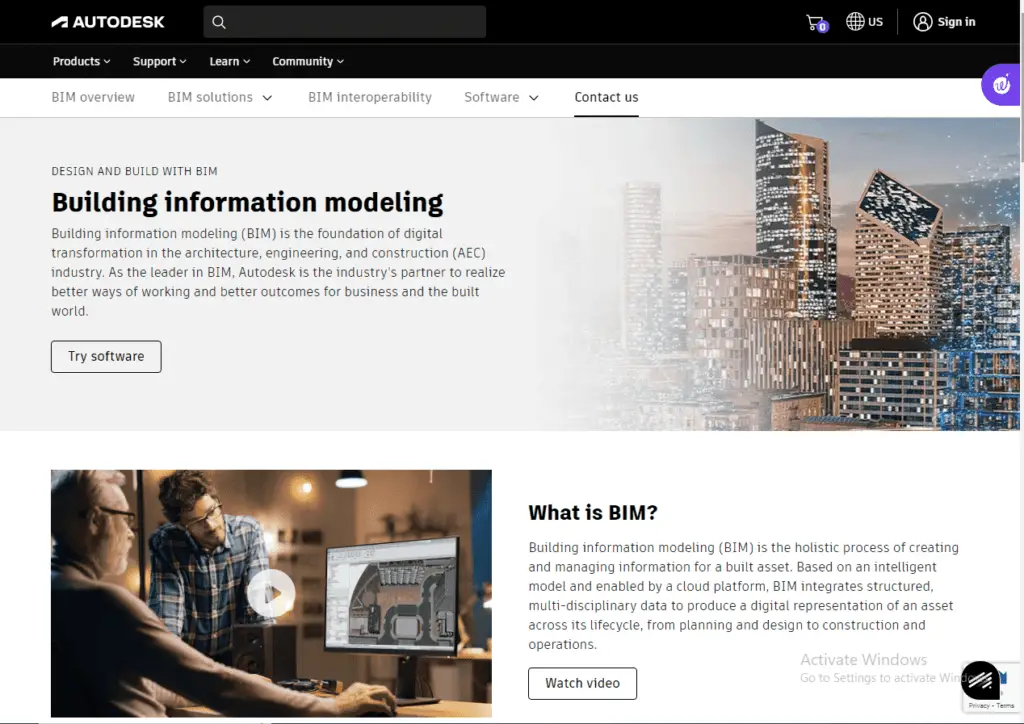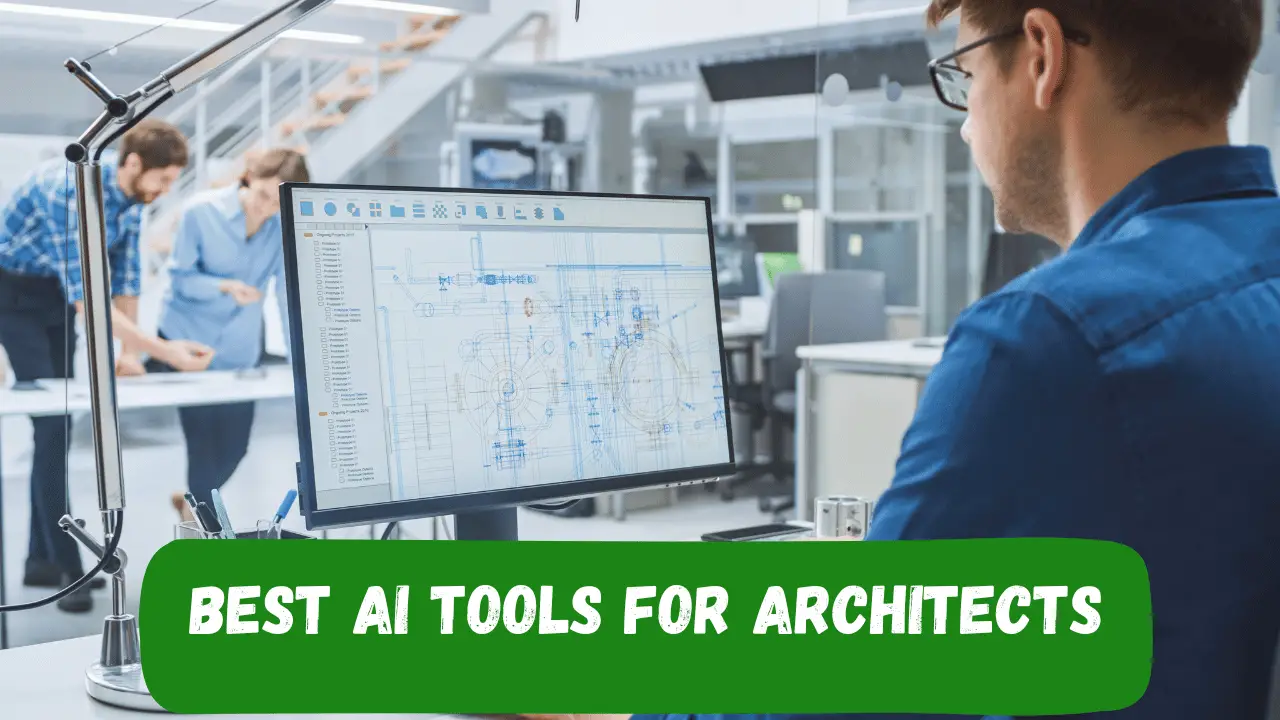As architects strive to create innovative designs that push the boundaries of creativity and functionality, they increasingly turn to AI tools to streamline their workflows and enhance their projects. In 2024, the landscape of AI tools for architects continues to evolve, offering a diverse array of solutions to meet the needs of professionals in the field.
From design exploration to project management, these AI tools empower architects to achieve their vision with greater efficiency and precision. And today we are going to discuss the top 11 AI tools for architects in 2024, both free and paid, along with their features, pricing, pros, and cons.
What Software do most architects use?
Most architects commonly use a combination of software tools tailored to their specific needs and workflows. Among the most widely used software are Computer-Aided Design (CAD) programs like AutoCAD and Revit, which facilitate the creation of detailed 2D and 3D designs.
Building Information Modeling (BIM) software such as Revit and ArchiCAD allows architects to create intelligent 3D models that incorporate data about building components and their relationships.
Visualization and rendering software like SketchUp and Lumion are also popular for creating photorealistic renderings and visualizations. Additionally, project management tools, collaboration platforms, and presentation software are essential for managing projects and communicating design ideas.
All these software are mainly used by Architects but the world is going to change by these AI tools that give more convenience and productivity to every Architect.
How to Become an AI Architect?
Becoming an AI architect requires a combination of education, experience, and specialized skills. Start by earning a degree in computer science, engineering, or a related field, with a focus on artificial intelligence and machine learning.
Gain practical experience through internships or research projects, honing your skills in programming languages such as Python and mastering AI frameworks like TensorFlow or PyTorch. Additionally, stay updated on the latest advancements in AI technologies and industry trends.
Cultivate strong problem-solving abilities and communication skills to effectively collaborate with cross-functional teams. Continuously seek opportunities to expand your knowledge and expertise in AI architecture.
Generative Design

Generative Design is using the power of AI algorithms to explore countless design possibilities based on input parameters, enabling architects to discover innovative solutions quickly and efficiently.
Using computational algorithms, Generative Design iterates through design options, considering constraints and objectives to generate optimized solutions. Architects use Generative Design to accelerate the design iteration process and explore a wide range of design alternatives, promoting creativity and innovation.
Features
- Automated design exploration and optimization.
- Generation of design alternatives based on specified criteria.
Pricing
Generative Design price starts from $200 per month or US$1600 per year. You can select any plan according to your needs.
Pros
- Accelerates the design iteration process.
- Encourages creativity and exploration.
Cons
- Requires a clear understanding of design parameters.
- May have a learning curve for some users.
BIM (Building Information Modeling) with AI Integration

BIM with AI integration enhances traditional BIM workflows by leveraging AI algorithms for data analysis and optimization, leading to improved project coordination and efficiency. AI algorithms are integrated into BIM software to automate error detection, clash detection, and data analysis tasks, optimizing project workflows.
Architects use BIM with AI integration to enhance collaboration, improve accuracy, and streamline project management processes. Many architects, engineers, contractors, and project managers require accurate and efficient project coordination and benefit most from BIM with AI integration.
BIM is web-based software and you do not need any system requirements to use it. You just need a 64-bit operating system with the latest browser.
Features
- Automated error detection and clash detection.
- AI-driven analysis and optimization of BIM data.
Pricing
BIM software offers 3 plans for us such as $120 for 1 month, $945 for a year, and $2,835 for 3 years.
Pros
- Enhances collaboration among project stakeholders.
- Improves accuracy and reduces rework.
Cons
- Initial setup and integration efforts required.
- Ongoing subscription costs for advanced features.
Site Analysis and Simulation

Site analysis and simulation tools powered by AI enable architects to evaluate environmental factors such as sunlight, wind flow, and energy performance, facilitating sustainable design decisions.
AI algorithms analyze environmental data to predict factors like daylighting, airflow, and energy consumption, guiding design decisions for optimal performance. Architects, environmental consultants, and sustainability specialists who prioritize green building practices and energy efficiency benefit most from site analysis and simulation tools.
Features
- Predictive modeling for environmental analysis.
- Simulation of daylighting, airflow, and energy performance.
Pricing
Its price varies based on the software provider and module selection, you can visit and get a free demo.
Pros
- Supports data-driven design decisions.
- Enhances project performance and occupant comfort.
Cons
- Complexity of simulation models may require specialized expertise.
- Limited free access to advanced features.
Designs.ai

Designs.ai offers AI-powered design tools tailored for architects, providing automated solutions for creating architectural graphics and presentations. It uses AI algorithms to generate graphic design assets, automate layout generation, and enhance branding solutions for architectural projects.
Architects use Designs.ai to streamline the design process, create professional-quality graphics, and maintain brand consistency across project deliverables. Architects, graphic designers, marketing professionals, and small architectural firms benefit most from Designs.ai’s user-friendly design automation tools.
Features
- AI-generated assets for graphic design.
- Automated layout generation and branding solutions.
Pricing
Design.ai offers 3 plans that are basic, pro, and enterprise per month and yearly. Besides web designing, it offers speech maker, logo maker, video maker, Image maker, and AI writer with the below packages.
- Basic: Best for Individuals and Marketers with full access to all premium temples, Wizard design generation, 1 seat, and many more at $19 Per month
- Pro: Best for teams with unlimited access to all features for designing a perfect web design, 1 seat for just $49.
- Enterprise: Best for large teams and agencies with 5 seats and unlimited features on $169
We suggest you, visit their pricing page to know about the products and features that they are offering with the above plans precisely.
Pros
- Simplifies the design process with AI-generated assets.
- Affordable pricing for architects and small firms.
Cons
- Limited customization compared to traditional design software.
- May not suit complex design requirements or advanced users.
SketchUp with AI Extensions
SketchUp with AI extensions enhances the popular 3D modeling software with AI-powered features for design optimization and automation. AI extensions for SketchUp integrate machine learning algorithms to automate design suggestions, optimize geometry generation, and enhance design workflows.
Architects use SketchUp with AI extensions to improve design efficiency, explore creative possibilities, and integrate AI-driven features seamlessly into their workflows. Architects, designers, artists, and hobbyists who rely on SketchUp for 3D modeling and visualization benefit most from AI extensions for SketchUp.
Features
- AI-driven design suggestions and automation.
- Integration with existing SketchUp workflows.
Pricing
SketchUp offers both free and paid plans but it’s paid plan gives us 7 days of free trail and it’s price start from $349 per year.
Pros
- Improves design efficiency and creativity.
- Integrates seamlessly with existing SketchUp workflows.
Cons
- Limited AI features in the free version.
- Additional cost for premium AI extensions.
AI-Powered Rendering Software
AI-powered rendering software accelerates the rendering process using machine learning algorithms, producing realistic visualizations with minimal user input. Rendering software utilizes AI algorithms to optimize rendering settings, improve rendering times, and enhance the realism of visualizations.
There are many AI-powered Rendering software for architects such as Midjourney, Adobe Firefly, ArchitectGPT, and Visoit. Architects, visualization artists, interior designers, and architectural visualization studios benefit most from AI-powered rendering software.
Features
- Faster rendering times.
- Enhanced realism and detail.
Pricing
Every software comes with different AI features and prices so you have to visit their pricing page to understand which plan will be perfect according to your specific needs.
Pros
- Speeds up the rendering workflow.
- Improves visualization quality.
Cons
- High initial cost for professional-grade software.
- Requires powerful hardware for optimal performance.
SkyCiv Structural 3D
SkyCiv Structural 3D analyzes building structures using advanced algorithms to predict performance and optimize designs for safety and efficiency. It employs AI algorithms to analyze structural behavior, predict loads and stresses, and optimize structural configurations.
Architects use AI-based structural analysis tools to ensure structural integrity, optimize material usage, and minimize the risk of structural failures in their designs. Architects, structural engineers, civil engineers, and construction professionals who require accurate structural analysis benefit most from AI-based SkyCiv Structural 3D tool.
Features
- Predictive modeling for structural analysis.
- Optimization of material usage.
- Pricing: Depends on software provider and usage.
Pros
- Improves structural integrity and efficiency.
- Reduces the risk of structural failures.
Cons
- Requires expertise in structural engineering principles.
- Limited free options available.
AI-Powered Project Management
AI-powered project management tools leverage machine learning algorithms to optimize project schedules, resource allocation, and budget management, streamlining project workflows and improving efficiency.
There are many AI-powered project management tools that Architects use, such as Ayanza, Stepsize, Zapier, Trello, and TaskAde. Project management software integrates AI algorithms to automate task scheduling, identify project risks, and provide insights for informed decision-making.
Architects use AI-powered project management tools to streamline project workflows, improve collaboration among team members, and ensure projects are completed on time and within budget. Architects, project managers, construction managers, and project stakeholders who oversee architectural projects benefit most from AI-powered project management tools.
Features
- Automated task scheduling and prioritization.
- Predictive analytics for risk assessment.
Pricing
Price varies based on different software providers and features. So, kindly visit their platform to know about the price. All tools provide different free trials and demos.
Pros
- Streamlines project workflows.
- Provides insights for better decision-making.
Cons
- Integration with existing systems may be complex.
- Limited customization options in some platforms.
Conclusion
At last, It’s time to select your best Archiet tools that must boost your productivity while decreasing effort and time. The list of AI tools for architects in 2024 is rich with innovation and potential. From accelerating design iterations to optimizing project management, these tools offer architects unprecedented opportunities to push the boundaries of creativity and efficiency.
As the architecture industry continues to evolve, embracing AI-driven solutions will be essential for staying competitive and delivering exceptional results.
By using the power of AI, architects can open new possibilities, streamline workflows, and ultimately, bring their visionary designs to life with greater precision and impact. The future of architecture is AI-powered, and the possibilities are limitless.
Frequently Asked Questions
What are AI tools for architects?
AI tools for architects are software applications or platforms that utilize artificial intelligence algorithms to assist architects in various aspects of their work, such as design exploration, project management, and simulation.
How do AI tools benefit architects?
AI tools benefit architects by streamlining workflows, improving efficiency, enhancing design exploration, facilitating collaboration, and enabling data-driven decision-making processes.
Do architects need technical expertise to use AI tools?
While some AI tools may require a certain level of technical proficiency, many are designed with user-friendly interfaces and intuitive features to cater to architects with varying levels of technical knowledge.
Are there free AI tools available for architects?
Yes, there are free AI tools available for architects, such as open-source software, freemium models, and trial versions offered by various vendors. These tools often provide basic functionalities with the option to upgrade to paid plans for advanced features.
How can architects integrate AI tools into their existing workflows?
Architects can integrate AI tools into their existing workflows by selecting tools that complement their specific needs and integrating them seamlessly with their existing software and processes. This may involve training team members, customizing workflows, and leveraging APIs for interoperability.

Hi, We are a professional team about exploring the latest AI apps and tools. With a keen eye for innovation, we meticulously analyze AI tools to provide our readers with top-notch guides. Stay informed with our expert insights as we navigate the ever-evolving landscape of artificial intelligence applications.





